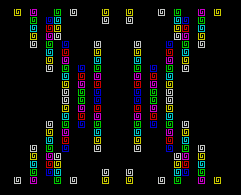Software:Psychedelia (light synthesizer)
 The ZX Spectrum version of Psychedelia | |
| Original author(s) | Jeff Minter, Simon Freeman |
|---|---|
| Initial release | 1984 |
| Written in | Assembly |
| Platform | Commodore 64, Vic 20, Commodore 16, ZX Spectrum, MSX and Amstrad CPC 464[1] |
| Type | Light synthesizer |
| Licence | Public domain |
| Website | www |
Psychedelia is an early light synthesizer developed by Jeff Minter and published by Llamasoft in 1984. It was converted to the MSX and ZX Spectrum by Simon Freeman.[2][3]
Usage
Psychedelia allowed a user to generate a light show on the screen grid, using the joystick to send pulses or bursts of coloured squares. There are various preset settings, or the user can manually set the variables controlling the pulses. Patterns can be recorded to memory or tape for later playback.[4]
Unlike Minter's later synthesizers such as Neon, Psychedelia does not use audio as a factor, only using a joystick's input. It is, however, intended to be played in accompaniment to music.[5]
History
Minter had been considering "dynamic interactive pattern generators" but hadn't coded any previously. An idea for an algorithm came to him, in which patterns would be seeded along a path, which would then expand and change shape and colour over time. He coded it in 6502 assembler language, fitting into about 1 kilobyte.[1] Running the code for the first time had a profound effect on Minter: "It just felt wonderfully new, and somehow primal... it was like the patterns and mandalas that have fascinated humans for millennia, but come to life, under your control..."[1]
Originally, Minter intended the algorithm to be public domain and contributed an early version in listing form to a computer magazine.[6] After encouragement from his parents, Minter eventually released an expanded version commercially as Pyschedelia.[1] He continued to develop the light synthesizer concept, designing Colourspace (1985), Trip-a-Tron (1987), Virtual Light Machine (1990, 1994, 2000 and an unreleased version in 2003) and Neon (2004).
Psychedelia, along with other older Llamasoft programs, has since become public domain software.[7] Later the author released a variant for Pebble devices.[8][9][10]
Critical reception
On its release Psychedelia received mixed reviews. Your Spectrum criticized the concept of a light synthesizer, describing Psychedelia as boring and awarding an average of 2/5.[11] Sinclair User also only awarded 2 out of 5, finding the concept interesting but concluding that the games-buying public was the wrong demographic for this kind of software.[12] In contrast, CRASH found the package great fun to play around with, describing the effects as fantastic, but criticizing the retail price and narrow appeal.[4] The magazine featured Psychedelia on their October 1991 covertape.[5]
See also
External links
- Official site at Llamasoft
- Disassembled source code for Psychedelia on the C64 at GitHub
References
- ↑ 1.0 1.1 1.2 1.3 Jeff Minter. "Psychadelia - History". Llamasoft. http://www.llamasoft.co.uk/psychedelia.php.
- ↑ "Psychedelia". World of Spectrum. http://www.worldofspectrum.org/infoseekid.cgi?id=0003915. Retrieved 2009-02-20.
- ↑ "Psychedelia (1984, Llamasoft)". Generation-MSX. http://www.generation-msx.nl/msxdb/softwareinfo/2807. Retrieved 2009-02-20.
- ↑ 4.0 4.1 "Psychedelia Review". CRASH (15): 20. April 1985. https://archive.org/details/crash-magazine-15. "[Psychadelia] is pretty expensive and the less imaginative among us may not be prepared to spend the time and extract all that this program has to offer".
- ↑ 5.0 5.1 "Game Thrills". CRASH (93): 9. October 1991. https://archive.org/details/crash-magazine-93. "It's a light show designed to be played while your fave music is blasting from your ghettobiaster!".
- ↑ "Psychedelia Listing". Popular Computing (Vol 3 No 50): 32. December 1984. https://archive.org/details/popular-computing-weekly-1984-12-13/page/n31/mode/2up?view=theater.
- ↑ "Permissions". lemon64.com. http://www.lemon64.com/?mainurl=http%3A//www.lemon64.com/games/permissions.php. "Llamasoft - Jeff Minter: "These game images may be distributed free of charge to anyone who wants to use them on emulators. Please feel free to carry them on emulator sites or whatever. Llamasoft feels that software old enough to be running on emulators is not going to be exactly generating a huge amount of revenue, and as such the images are considered by Llamasoft to be in the public domain, and there will be *no* legal hassles if your site carries the images.""
- ↑ "Psychedelia" and source code also now up on the app store. All free of course! on twitter.com by Jeff Minter@llamasoft_ox (22 Jun 2015)
- ↑ Download from archived Pebble store on apps.rebble.io
- ↑ Source Code Repository on github.com Empty repository for source code.
- ↑ "Joystick Jury". Your Spectrum (14). May 1985. http://www.users.globalnet.co.uk/~jg27paw4/yr14/yr14_43.htm. Retrieved 2009-02-20.
- ↑ John Gilbert (August 1985). "Spectrum Software Scene". Sinclair User (41): 26.
 |

